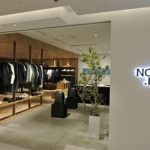Levi Strauss reported sales at Beyond Yoga surpassed expectations in the first quarter ending February 27, and the brand is making progress in being positioned for accelerated growth.
Levi’s acquired Beyond Yoga last September for $400 million. Beyond Yoga’s sales totaled $26 million in the first quarter. Levi’s has projected that the brand’s sales will exceed more than $100 million in 2022.
“The integration of Beyond Yoga continues to go well,” said Chip Bergh, Levi’s CEO, on a call with analysts. “The brand has started the year strong, exceeding our expectations in Q1. It’s a well-positioned premium brand but significantly expands our total addressable market while contributing to the company’s diversification. Beyond the business results, we are very focused on building the capability to scale the business and have started making some terrific hires in e-commerce, brick-and-mortar and marketing.”
In purchasing Beyond Yoga, Levi’s has said it allows the company to “authentically enter” the activewear market, which officials said is five times bigger than denim and growing at a faster rate. The purchase was seen as diversifying its product mix and complementing its growing women’s business. More than half of Beyond Yoga’s customers are under 35.
Asked for an update on the acquisition in the Q&A section of the quarterly call, Bergh said, “We are largely through the heaviest lift of the integration. I would say it’s gone really well. The team is terrific. The brand started with its first full quarter as part of Levi Strauss strong, and beat their internal expectations or our internal expectations.”
Bergh called out the culture fit becoming apparent between the organizations. The key leaders and the majority of the approximately 90 Beyond Yoga employees have remained with the brand and are now part of Levi Strauss. Eighty-eight percent of women’s-founded brand employees are women.
“It is clear that there is a very strong culture fit,” said Bergh. “This is our first acquisition in decades. This is going to be a good win-win. We’re learning a lot from them. They’re a small, scrappy team, and every day they are on every single piece of detail. We’re learning things from them as they are learning things from us, which will play out nicely.”
He said Beyond Yoga is a “premium-priced brand” that significantly adds to the total addressable market Levi’s competes in. For 2022, Beyond Yoga plans to expand its men’s and maternity businesses, opening its first retail doors and further developing the brand’s wholesale footprint with premium partners.
Said Bergh, “Our focus is beginning to build capability because we didn’t buy this business because we thought it would be a $100 million business this year. We bought it because we believe it has the potential to be much, much bigger. We have built plans to that effect and, in June, when we’re all together on June 1 for Investor Day, we will reveal more of that but, I believe that this is going to be big for this company and be a generator of meaningful growth over the next several years.”
In the first quarter, Levi’s profits and sales topped internal guidance and Wall Street expectations. Demand for its core denim product remained strong as casualization trends accelerated during the pandemic, and a shift toward looser-fit denim drove sales.
“We continue to benefit from several consumer trends that uniquely position us in the marketplace, including the global casualization, return to the office and the new denim trend,” said Bergh. “Levi’s engine is strong, our core business is strong, as evidenced in the U.S., and the good news for us is that all our brands—Dockers, Beyond Yoga, Signature, Denizen—besides Levi’s are showing momentum and accretive to growth.”
Bergh added that Levi’s brand equity “has never been stronger” and is not only supporting growth but helping the brand support price hikes to offset inflationary pressures. Levi’s raised AURs (average unit retail prices) by 10 percent in the period.
“Our ability to effectively take price has enabled us to mitigate cost pressures, including inflation in inputs and logistics. These decisions are instructed by powerful proprietary technology and analytics, including artificial intelligence and methodical analysis of price elasticity,” said Bergh. “In fact, even as we have raised prices, consumer demand has continued to grow, and Levi’s brand unit volume has now returned to 2019 levels. We took select pricing actions last year as well as early this fiscal year, and we believe there remains additional headroom to raise prices in parts of our portfolio through the balance of this year and beyond as we continue to innovate and lead trends.”
In the quarter, companywide sales grew 22 percent to $1.6 billion, topping Wall Street’s consensus target of $1.58 billion, and gained 26 percent on a constant-currency basis, excluding $38 million in unfavorable currency impacts. The gains were driven half by higher volumes and half by an increase in AURs.
Supply chain-related issues limited further revenue opportunities by approximately $60 million or 5 percent, primarily in the U.S., where the consumer continues to be strong with demand outpacing supply.
Direct-to-consumer (DTC) revenues increased 35 percent, driven by company-operated stores and e-commerce. As a percent of first-quarter company net revenues, sales from DTC stores and e-commerce comprised 30 percent and 9 percent, respectively, for a total of 39 percent.
Wholesale net revenues increased 15 percent, reflecting demand for Levi’s brand globally. The company’s global digital net revenues grew approximately 16 percent compared to the same period in the prior year and comprised approximately 25 percent of first-quarter fiscal 2022 net revenues.
Gross margins improved to 59.3 percent from 58.2 percent in the prior year’s same quarter. Adjusted gross margin, which excludes COVID-19 and acquisition-related charges, was 59.4 percent, increasing 170 basis points compared to the same period in the prior year. The increase in gross margin reflects a higher proportion of sales in our DTC channel, lower promotions, higher share of full-price sales, and price increases, partially offset by higher product costs.
As a percent of revenues, adjusted SG&A was 44.5 percent, approximately 20 basis points higher than the prior-year period, reflecting higher investments in advertising and promotion and higher distribution expenses, partially offset by leverage in selling expenses.
Operating income of $234 million compared to $177 million in the same quarter in the prior year. Adjusted EBIT of $238 million compared to $174 million in the prior year’s same quarter. The increases were primarily due to higher net revenues and gross margin, partially offset by higher SG&A expenses in the current year.
Net income was $196 million compared to $143 million in the same quarter of the prior year. On an adjusted basis, net earnings rose 34.9 percent to $189 million, or 46 cents a share, exceeding Wall Street’s consensus estimate of 42 cents.
By region, net revenues in the Americas grew 26 percent on a reported basis and 27 percent on a constant-currency basis, driven by growth across its DTC and wholesale channels. DTC net revenues increased 31 percent due to strength in company-operated stores as consumers returned to in-person shopping. Wholesale net revenues grew 24 percent, driven by strong performance across brands, particularly Levi’s brand. Net revenues through all digital channels grew 24 percent and represented 24 percent of the segment’s sales in the quarter. Operating income for the region increased due to higher net revenues and gross margins.
In Europe, net revenues grew 13 percent on a reported basis and 21 percent on a constant-currency basis. DTC net revenues increased 46 percent, driven by strength in company-operated stores as the severity of the pandemic lessened, allowing consumers to return to our stores. Wholesale net revenues decreased 4 percent on a reported basis while increasing 3 percent on a constant-currency basis. Net revenues through all digital channels declined 8 percent following an 84 percent increase in the same period last year and represented 29 percent of the segment’s sales in the quarter. Europe’s operating income increased due to higher net revenue and gross margins, partially offset by higher SG&A expenses as a percentage of net revenues.
In Asia, net revenues increased 11 percent on a reported basis and 14 percent on a constant-currency basis. The increase in net revenues was driven by DTC and wholesale channels and most markets, despite several markets continuing to experience COVID-related impacts. DTC net revenues increased 17 percent, driven by strong performance in company-operated stores and e-commerce, up 22 percent. Wholesale net revenues increased 5 percent, driven by the strength of Levi’s brand across several markets. Net revenues through all digital channels grew 17 percent and represented 14 percent of the segment’s sales in the quarter. Operating income for the region increased due to higher net revenue, gross margin, and lower SG&A expenses as a percentage of net revenues.
For Other Brands, Dockers and Beyond Yoga combined, net revenues and operating income increased, reflecting growth across channels for the Dockers brand and the acquisition of Beyond Yoga.
Looking ahead, Levi’s reaffirmed its expectations for fiscal 2022, which call for net revenue growth of 11 percent to 13 percent compared to FY 2021, to between $6.4 billion and $6.5 billion, and adjusted diluted EPS of between $1.50 to $1.56.
Harmit Singh, CFO, said, “While we are maintaining our outlook, we expect it will now be comprised of even stronger growth in the Americas, primarily led by the U.S., and continued strength in Asia, offset by reduced growth in Europe due to the unfavorable foreign exchange rate and the reduced revenue expectations in Russia. Our outlook assumes no material worsening of the current condition.”
Photo courtesy Beyond Yoga
















